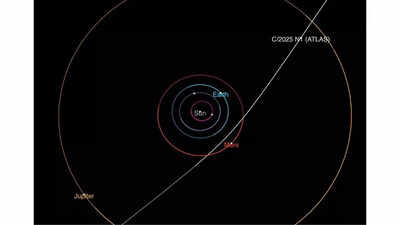An enigmatic object believed to have originated from beyond our solar system has been spotted traversing our cosmic neighborhood. The object, officially designated 3I/Atlas (C/2025 N1), was first observed on July 2, 2025, by the ATLAS survey telescope in Chile. This marks only the third confirmed interstellar visitor, following ‘Oumuamua in 2017 and comet 2I/Borisov in 2019.
Traveling at an astonishing speed of 60 km/s and currently situated approximately 416 million miles from the Sun, the object follows a hyperbolic trajectory, indicating its likely origin outside our solar system. NASA has confirmed that 3I/Atlas poses no threat to Earth.

Initially cataloged as A11pl3Z, the object was discovered by the Asteroid Terrestrial-impact Last Alert System (ATLAS) in Chile. Subsequent observations by NASA and other observatories traced its path back to June 14, confirming a hyperbolic orbit indicative of interstellar origins. Now officially named 3I/Atlas, it joins the exclusive club of confirmed cosmic wanderers, reinforcing the idea that such objects may be more prevalent in the galaxy than previously thought. The object is currently approaching the inner solar system from the direction of the constellation Sagittarius.
While initially classified as an asteroid, recent observations have revealed subtle signs of cometary activity. The Minor Planet Center detected a faint coma and a short tail, leading to its dual classification as C/2025 N1. Initial brightness estimates suggested a size of approximately 20 kilometers in diameter; however, experts now believe that the surrounding dust cloud may be exaggerating its apparent size, and that its solid core is likely smaller. It is projected to reach its closest proximity to the Sun around October 30, venturing just within the orbit of Mars.
Although its origins are extraordinary, NASA assures that 3I/Atlas will maintain a safe distance from Earth, never approaching closer than about 150 million miles. As it approaches the Sun, the object is expected to brighten, potentially becoming visible through amateur telescopes in late 2025 and early 2026. The Virtual Telescope Project plans a live broadcast for enthusiasts eager to witness this rare phenomenon. Scientists hope that studying this object will provide valuable insights into the composition and behavior of interstellar bodies.
Newer articles
Older articles
 Black Caps Set for Blockbuster Home Summer Against Cricket Giants
Black Caps Set for Blockbuster Home Summer Against Cricket Giants
 Elon Musk Calls for ISS Retirement, Citing Mars Focus After $1.25B Allocation
Elon Musk Calls for ISS Retirement, Citing Mars Focus After $1.25B Allocation
 Sharma Reveals Heart-Stopping Moment of Yadav's Game-Changing Catch in T20 World Cup
Sharma Reveals Heart-Stopping Moment of Yadav's Game-Changing Catch in T20 World Cup
 Daren Sammy Fined, Receives Demerit Point for Umpire Criticism After Test Match Controversy
Daren Sammy Fined, Receives Demerit Point for Umpire Criticism After Test Match Controversy
 Smith Aims for Second Test Return After Unique Baseball Cage Recovery
Smith Aims for Second Test Return After Unique Baseball Cage Recovery
 Gujarat Cricket Association Gears Up to Launch T20 League in 2025-26 Season
Gujarat Cricket Association Gears Up to Launch T20 League in 2025-26 Season
 Najmul Hossain Shanto Resigns as Bangladesh Test Captain After Sri Lanka Defeat
Najmul Hossain Shanto Resigns as Bangladesh Test Captain After Sri Lanka Defeat
 Man City Title Stripping: Unprecedented Chaos Looms for Premier League Amid Financial Allegations
Man City Title Stripping: Unprecedented Chaos Looms for Premier League Amid Financial Allegations
 Ex-India Star Engineer Slams ECB's Pataudi Trophy Renaming, Questions Anderson-Tendulkar Choice
Ex-India Star Engineer Slams ECB's Pataudi Trophy Renaming, Questions Anderson-Tendulkar Choice
 Jin's Solo Concert in Korea: A Reunion with ARMY, Surprise Guests, and Electrifying Performances
Jin's Solo Concert in Korea: A Reunion with ARMY, Surprise Guests, and Electrifying Performances